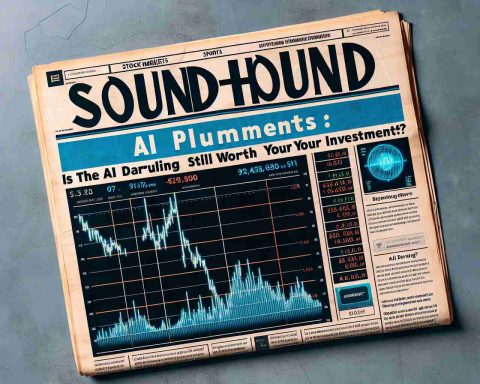- The S&P 500 faces instability despite high valuations, with investors wary of looming uncertainties.
- International trade tensions threaten economic equilibrium, raising concerns over prolonged trade wars.
- Rising government deficits could strain fiscal health further, adding financial risks.
- The technology sector is vulnerable, with “Big Tech” valuations seen as precariously inflated.
- An increase in bond yields, particularly the 10-year Treasury nearing 5%, may trigger market sell-offs.
- Foreign political tensions affect global bond markets, influencing investor behavior.
- China’s real estate issues, exemplified by Evergrande, pose a threat to global economic stability.
- Investors are advised to heed market warnings, diversify portfolios, and explore smaller-cap investments.
- The market’s journey requires vigilance and caution to navigate potential financial disruptions.
Despite the S&P 500 teetering at dizzying heights, investors walk a perilous path, haunted by uncertainties that could trigger a market shake-up. Like mountaineers scaling a “wall of worry,” they navigate potential landmines that could shift the market’s landscape dramatically.
Among these invisible pitfalls, international trade tensions threaten to upheave the current equilibrium. The specter of a prolonged trade war looms large, casting shadows over the seemingly robust economy. The ever-expanding government deficit adds another layer of concern, stretching the fiscal fabric thinner and thinner.
The technology sector, crown jewel of recent gains, appears precarious as “Big Tech” valuations hover like balloons filled with too much hot air—a mere pinprick could send them tumbling. A jittery trigger could be the bond market, where an uptick in yields might spark a sell-off frenzy. Should the 10-year Treasury yield ascend swiftly toward the 5% mark, market stability could be at risk. Foreign political tensions could exacerbate this, as global powers rethink their bond purchases amidst strife.
Within this intricate web of concerns rests a slumbering giant: China’s real estate turmoil. The cautionary tale of Evergrande reflects an economic iceberg, biding its time beneath a sea of distressed debt. A collapse in China’s housing sector holds potential to ripple outward across global markets, much like the US housing crisis did in the past.
Investors grow alarmed as market signals, like the December Low indicator, flash warnings of vulnerability. Historical patterns whisper advice: tread carefully, diversify wisely. Amidst the shadows of inflated valuations, the prudent eye seeks haven in less glamorous corners, considering smaller-cap opportunities.
In this relentless climb, the message is clear: vigilance over complacency, caution over bravado. The market’s ascent is exhilarating, but treacherous undercurrents call for a steady grip and wary glance at the horizon.
Is the Market Bubble Set to Burst? What Investors Need to Know
How-To Steps & Life Hacks for Navigating Market Uncertainty
1. Diversify Investments: Spread your risk by investing in a variety of assets, including stocks, bonds, commodities, and real estate. This helps mitigate potential losses in any one sector.
2. Focus on Fundamentals: Analyze company and sector fundamentals before investing. Look at earnings, P/E ratios, and debt levels.
3. Custom Alerts and News Feeds: Set up real-time alerts for market news and stock price changes. Use services like Bloomberg or Reuters for up-to-date information.
4. Consider Hedging Strategies: Use options or derivatives to protect against potential downsides. Consult with a financial advisor to understand these strategies.
Real-World Use Cases
– Retirement Planning: Diversifying portfolios ensures a balance between growth and security, essential for long-term financial planning.
– Educational Savings: Parents can use diversified investment strategies to build a stable fund for their children’s education while mitigating risk.
– Corporate Treasury Management: Companies use diversified investments to manage cash reserves strategically, balancing risk against expected returns.
Market Forecasts & Industry Trends
Analysts predict continued market volatility due to geopolitical tensions and uneven economic data. The technology sector, susceptible to valuation bursts, remains a focal point. Moreover, market analysts see potential slowdowns in growth due to higher interest rates influencing borrowing costs.
Reviews & Comparisons
In recent comparisons, smaller-cap stocks have shown resilience and outperformed larger-cap stocks in specific sectors by offering investors exposure to untapped growth potentials. However, large-cap stocks historically provide more stability during downturns.
Controversies & Limitations
Critics argue that high valuations in the tech sector are unsustainable, leading to potential corrections. Others highlight the lack of transparency in China’s real estate market, making it difficult to assess true risks.
Features, Specs & Pricing
Investors can examine ETF options such as:
– Vanguard Total Stock Market ETF (VTI): Offers broad market exposure.
– SPDR S&P 500 ETF (SPY): Tracks the performance of the S&P 500 index.
– Invesco QQQ ETF: Focuses on the Nasdaq-100, offering tech-heavy exposure.
ETFs generally feature low-cost ratios and high liquidity, ideal for diversifying with a single investment product.
Security & Sustainability
The current discourse around ESG (Environmental, Social, Governance) investing highlights sustainable practices. Many investors now prefer companies with strong ESG credentials, which tend to show resilience during market fluctuations.
Insights & Predictions
Economic indicators suggest that while strong growth is likely, potential pitfalls could trigger downturns, making vigilance crucial. Analysts recommend monitoring interest rates and geopolitical developments closely.
Tutorials & Compatibility
Numerous online platforms like Investopedia offer tutorials on understanding market indicators and using financial tools for investment decisions.
Pros & Cons Overview
Pros:
– Diverse Investment Options: Broader market exposure with diversified portfolios.
– Potential High Returns: Capitalize on growth sectors like technology.
Cons:
– Market Volatility: High market sensitivity, particularly in tech and emerging markets.
– Interest Rate Risks: Rising rates can affect borrowing costs and valuations.
Actionable Recommendations and Quick Tips
– Monitor Central Bank Policies: Keep an eye on interest rate announcements from the Federal Reserve.
– Regular Portfolio Review: Assess your portfolio every quarter to align with market changes.
– Stay Informed: Engage with financial news updates to anticipate market trends.
For further insights, visit CNBC or Bloomberg for the latest financial news and analysis.
By keeping informed and maintaining a diversified portfolio, investors can better navigate the uncertainties looming over the financial landscape. Keep your investment strategies adaptive and remain vigilant to protect against market instability.


















